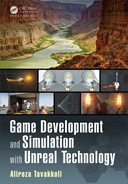
Materials in Unreal Engine 265
Object Bounds: This expression outputs the size of the o bject in each axis.
Example Usa ge: You can u se the X, Y, an d Z values of this expression as the R,
G, and B c olors of an object to change its color based on its size and shape.
Reflection Vector: This expression outputs a three-channel vector value represent-
ing the direction of the reflec tion with respect to the surface.
Example Usa ge: Much like Camera Vector, the Reflection Vector is often
used to fake environment maps by connec ting the Camera Vector to a
Component Mask a nd use the x and y channels of the Reflection Vect or
as texture coordinates.
4.7 SUMMARY
In this chapter we worked with materials and the material e ditor in Unreal Engine
4. Materials are much mor e complex than just the paint applied to a surface. They
encode within themselves the way in which light interacts with and reflects from a
surface in Unreal Engine.
A list of com monly used material expressions were discussed with example us-
ages of most commonly used expressions. We also learned about the concept of phys-
ically based materials, a newly introduced concep t revealed in SIGGRAPH 2013
[55] and how the shading model in UE4 makes use of two new material cha nnels
(Metallic and Roughness) to simulate physically re alistic mater ia ls efficiently.
Much like other chapters in this book, we first learned about the features and
functionalities of the engine’s rendering compon ent. We the n went through a series
of Tutorials aimed to help us learn how to create ma te rials in the material editor, how
to build up our material from a simpler version of itself and create com plicated visual
simulations of the real-world materials in Unreal Engine 4.
We learn ed to c reate simple materials based on textures. We used normal maps to
add more depth and realism to our materials. We learned how we can procedurally
adjust normal maps to create m ore details an d depth. An important and newly intro-
duced functionality in UE4 to physically chan ge the geometry of an object via the
World Displacement and Tessellation Multiplier channels was introduce d
to us in one of the Tutor ia ls in this chapter.
We also lea rned how to create dynamic materials by utilizing Coordinate ex-
pressions. Time-based mathematical calcula tions can also provide time-dependent
features into our materials’ functionalities. We used time-based networks in our ma-
terials for time varying looks a nd features.
266 Game Development and Simulation with Unreal Technology
4.8 EXERCISES
Exercise 1. Create the materials shown in Figure 4.6.
Exercise 2. Create the materials shown in Figure 4.7.
Exercise 3. Create the materials shown in Figure 4.8.
Exercise 4. Create the materials shown in Figure 4.9.
Exercise 5. Create the materials shown in Figure 4.10.
Exercise 6. Create the materials shown in Figure 4.11.
Exercise 7. Create the materials shown in Figure 4.12(a).
Exercise 8. Create the materials shown in Figure 4.13(a).
Exercise 9. Create the materials shown in Figure 4.14.
Exercise 10. Create the m aterials shown in Figure 4.15.
Exercise 11. Create the m aterials shown in Figure 4.19.
Exercise 12. Create the m aterials shown in Figure 4.22.
Exercise 13. Create the m aterials shown in Figure 4.23(a).
Exercise 14. Create the m aterials shown in Figure 4.23(b).
Exercise 15. In Tutorial 4.6 what happens if the Panner expression is not connected
to the UVs channel of the Texture expression with the Flame tex-
ture? Explain.
..................Content has been hidden....................
You can't read the all page of ebook, please click here login for view all page.
